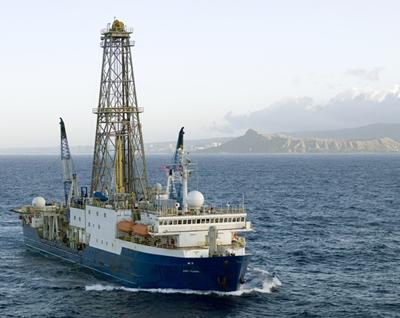Scientists based at the National Oceanography Centre, NOC, are onboard the RV JOIDES Resolution as part of the Integrated Ocean Drilling Program, IODP. Expedition 340 will look at volcanism and landslides around the Lesser Antilles.
March 26, 2012
We are now at the halfway point in the cruise and focused on the drill sites off of Martinique. However, Montserrat is still very much on our minds.
Adam Stinton of the Montserrat Volcano Observatory is on board and has been accessing the real time data from the island's seismic stations and remote cameras. These showed that shortly after we left the site there was a period of seismic activity in the early hours of Friday 23rd (local time), followed several hours of ash venting. It would have been nice to see the volcano in action while we were coring, but we have the consolation that updated palaeo-magnetic and biostratigraphic information from our last site at Montserrat shows that we have a complete record of volcanic activity extending back four and a half million years, two million years longer than we previously thought.
We have just completed our first site close to Martinique and obtained a similarly impressive record of volcanic activity from the upper 100 metres of the hole. It doesn't extend back as far as the Montserrat record, but it does contain many more tephra layers, so our logging team have been particularly busy trying to record as much information as possible in the relatively short time available before the next core arrives on deck. The picture shows Pete Talling from NOC logging a section of hemipelagic sediment (pale layers), volcanic turbidites (thick dark layers) and ash fallout (thin dark layers), with Yoshi Tamura (Japan) and Adam Stinton.

March 19, 2012
The second weekly update from IODP leg 340.
At about 5 o'clock this morning (local time) we finished drilling the final site around Montserrat and are preparing the ship for a 12 hour transit to our next site off the coast of Dominica.
The relatively shallow depths in which we are working mean that cores have been arriving on deck every 45 minutes during some periods. We have also been able to use the advanced piston corer for most of the time, which has meant high recovery rates. Each of the past three sites has also been double-cored to ensure that we get as complete a recovery of the sediments as possible. All of which means that the two core description teams has been working particularly hard over the past ten days. Pete Talling, from NOC, has been leading the midnight to midday core logging shift and has also been providing "Rolf Harris" cartoons (his words!) to keep the science party updated about progress.
Clearly, there will be a lot of work to do on the material before we are able to provide a complete story from the area, but Pete is pretty confident that we have the core available to allow us to address one of the central questions of the cruise; namely, whether the massive debris flows that appear to originate from Montserrat are the result of single collapse events (in which case they could present a significant geohazard), or whether the debris deposits are formed from a number of closely-spaced smaller events. In the case of the latter, the hazard is very much lower.
The last site was on a basement high to the southwest of Montserrat. Preliminary palaeomagnetic data suggest the sediments at the base of the 130 m core are approximately two and a half million years old. Core recovery was essentially 100% and showed numerous volcanic horizons separated by hemipelagic sediments. So, we hope to be able to generate a detailed record of volcanic activity in the region over this period.
March 12, 2012
We set sail from San Juan, Puerto Rico on Monday March 5th.
None of the scientists on this leg had ever sailed on the Joides Resolution before, so we had a fairly intensive period of training into how everything works. The equipment was already set up and waiting, and it is backed up by an excellent group of IODP staff.
Our first drill site was close up to the volcano and into the margins of the debris flows originating from various dome collapse events since Montserrat became active again in 1995. From previous cruises to the area we knew this was going to be a tough site to recover material from because of the blocky nature of the deposits - and so it proved. Still, we managed to get down to ~50 m below seafloor and recover enough material to make it worthwhile.
Our next site was a further 10 km from the island, and met with much better success. We drilled through the top layer of debris flows, that were about 100 m thick, and into the underlying pelagic carbonates. These contained lots of volcanic layers with some interesting diagenetic and bioturbation relationships. We also managed to penetrate into another debris flow at a depth of ~220 m, but unfortunately the drill string became stuck when we tried pull out. Eventually it was decided to blow our way clear, and we are now just about to drill a second hole at the site.
